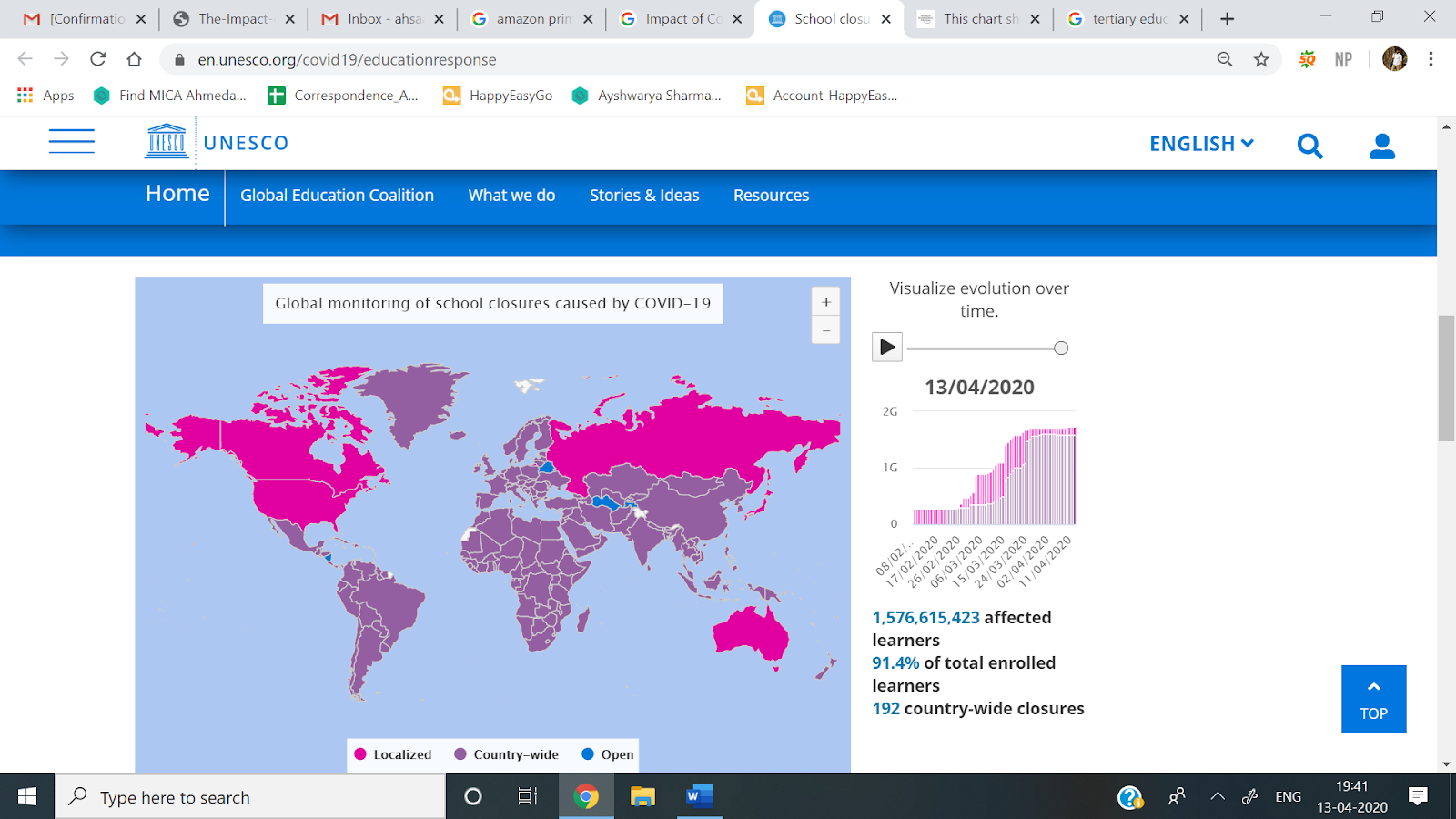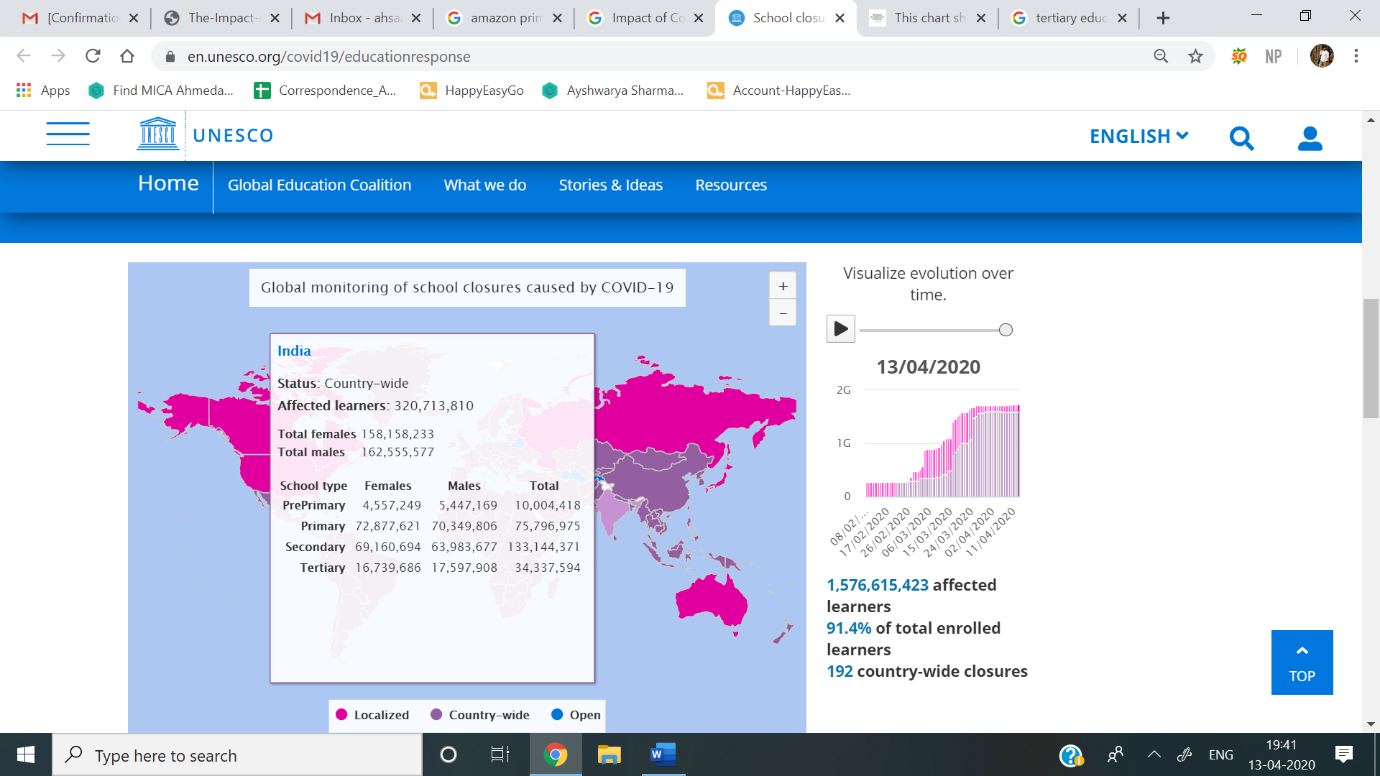By Ahsaas Verma

- Introduction
- Impacts on education – Schools & College / Universities globally
- Solution
- Understanding the economic impact
- Maximise online learning
- Develop robust systems
- Educate students on best practices
- Gather information and apply learnings
Introduction
COVID-19, popularly known as the CoronaVirus has impacted the lives of millions, or practically everyone on the face of the Earth. The industries have been bracing themselves for adverse impact of the virus in the future. Countries have come to a standstill, where a few argue that it might be a boon for the environment and mother nature, others are of the opinion that this will lead to a greater crisis than the great depression.
With PM Modi’s speech due on 14th April at 10 AM, India is thinking about the longevity of the lockdown that we are currently in. While some argue that the duration of this lockdown shall be extended, others are pleading to lift it from places with no signs of the virus.
What we need to understand is that lockdown or no lockdown
The decision of the government will be one that we would need to abide by since “Corona” is not about a few holidays or time with family but rather a global pandemic that needs to be controlled and then made extinct from the face of the earth for resuming “normal human life”.
Schools and colleges have declared ‘Summer Holidays’ for students all around the country due to this pandemic. The word says that schools won’t reopen until at least June 10. With such big academic decisions on the line, let’s have a look on the impact COVID-19 has had on education (WEF, 2020).
Top
Impacts on education – Schools & College / Universities globally
UNESCO released its figures on 23rd March, 2020 stating that 1.3 billion (1 Cr. 30 Lacs or 1,379, 344, 914 students) learners around the world were unable to attend school or university (on that day). The ‘learners’ here refers to those enrolled for pre-primary, primary, lower secondary, upper secondary and tertiary levels (including schools and colleges).
Various entrances to go abroad and even for colleges in India, have either been postponed or if the results are out, the communication is delayed. Internships of many B-schools are being revoked with actual threats on final placements of the college. Institutions like HRD Ministry, AICTE etc. have been approached to minimize the adverse impacts on students, but substantial information can only be gained once the pandemic comes to a halt.


The UNESCO website provides detailed data about closures of schools worldwide. The data also covers what the UN defines as ‘learners’ on geographic and academic fronts. The legend provides an understanding of whether the institutions are open in that area, if there is a country-wide shut down or a localized one. India specific data is also provided on the website, as can be seen in the picture attached. This data is specific to 13th April, 2020 (UNESCO, 2020). “We are working with countries to assure the continuity of learning for all, especially disadvantaged children and youth who tend to be the hardest hit by school closures,” UNESCO Director-General Audrey Azoulay said in a statement.
“While temporary school closures as a result of health and other crises are not new unfortunately, the global scale and speed of the current educational disruption is unparalleled and, if prolonged, could threaten the right to education.” Lucia Azilona, Education Minister, Italy, one of the worst hit countries, announced the schools to stay closed until further notice. In Washington State, where multiple cases of coronavirus have been reported, health officials have said there is no set protocol for school closures. “Our priority is the health and safety of our students, and we are taking extra steps to prevent and contain the disease,” Seattle Public Schools said in a statement. China and Japan have also adhered to the shutdown policy adopted by the world. (McCarthy, 2020).
Top
Solution
In these testing times, the solution pertains more towards understanding and awareness of the problem. The following steps can be incorporated for better coping of the situation –
Top
Understanding the economic impact
The virus has forced many students to abstain from travel. While travel restrictions to and from China have been helpful in slowing down the spread of the disease, they have also left international students stranded. According to a COVID-19 Survey by the Institute of International Education (IIE), 830 Chinese students have been unable to return to the US to continue their studies. While this may be a small percentage of the overall international student population, the question remains: How long will this last? If the restrictions remain in place, the global higher education system could bear the brunt of an economic downturn.
To understand, be aware and cooperate in this downturn is the first step towards coping with the global pandemic.
Top
Maximise online learning
The most effective tool in keeping student retention and maintaining access to learning has been online courses. Stanford University has called off the remaining two weeks of in-class lectures, urging its professors to move any remaining lessons online. The University of Washington announced a ban on on-campus classes until after spring break, after a member of staff was diagnosed with coronavirus last week. Other universities, including New York’s Hofstra University, New Jersey’s Princeton University and Seattle University are starting to make the move to virtual classes. Many IIM’s, IIT’s, MBA colleges and even school’s in India have made online classes compulsory during the testing times.
Top
Develop robust systems
While the majority of colleges and universities around the world integrate some form of online education into their coursework, moving all programs online may prove challenging. While some universities may already have strong online systems, smaller universities may struggle under the weight of the demand. University course creators should work closely with their IT departments to ensure their programs are able to be supported online.
One such university that is currently undertaking these measures is the University of Southern California, which is testing its online platforms to ensure its technology can handle its 7,000 plus lectures.
Top
Educate students on best practices
With online learning the way to go, universities should also ensure students and staff are protected while on campus. While COVID-19 is a high risk for those over 60, traditional-aged university students face relatively low risks from the disease. However in recent weeks, we have seen just how quickly the novel coronavirus can spread in areas with a high concentration of people – and university campuses are no exception.
Administrators should undertake simple measures to prevent the spread of the disease on their campuses. This should include instructing students on the appropriate protocols for hand washing, covering sneezes and coughs with their elbows, and self-isolating if they are experiencing flu or cold-like symptoms.
Educators should also be aware of students who have travelled extensively during the spring break, and remind those who have been abroad in heavily affected places to be mindful about returning to campus.
Top
Gather information and apply learnings
Universities and colleges yet to implement changes to campuses in response to the novel coronavirus should take cues from others who have already taken action. They should analyse the steps already taken by other educators to understand what has worked, what hasn’t worked and how to tackle the challenges they may face. With the spread of the disease expected to worsen before it gets better, administrators should take quick action to safeguard their campuses and students in preparation for potential closures.
But it’s not all doom and gloom. The higher education sector has withstood turbulent economic times in the past, and it will withstand them again. In a digital age, universities and colleges are better placed today more than ever to provide students with easy access to continue their studies online (Hodge, 2020).
Top
Recommended Read
- Essays in English
- Essay on My Father in English
- Essay on Mahatma Gandhi in English
- Essay on Swami Vivekanand in English
- Essay on Shaheed Bhagat Singh in English
- India’s 15th President Draupadi Murmu, Essay in English
- Essay on Cruelty to Animals in English
- Essay on Importance of English
- Plastic ban – Are we doing enough?
- Essay on my family
- Essay on My best friend
- Essay on Impact of Poverty on Education
- Essay on The Wonder Called Science in English
- Essay on Mobile Phones in English
- Agnipath – A New Recruitment Scheme of Indian Armed Forces
- Role of Technology in Education? English Essay
- What is Exam Result Anxiety and How to Reduce it
- Should Facebook be banned? English Essay
- Suicide Among Students Due to Parental Pressure
- Should selling and using tobacco be banned? English Essay
- Social Media – A cause of Anxiety and Depression
- Should Smoking in Public Places be banned? English Essay
- Essay on Should children get limited access to the Internet?
- Should Education be Free? English Essay
- Coronavirus: Coping With Viruses in the 21st Century: Are we ready?
- To Zoom or Not to Zoom – Is it Safe for Official meetings in 2020?
- Online Education : A Boon or A Curse?
- Citizenship Amendment Act – Confusion and Arguments Explained
- Merger of Banks in India – What are the advantages and disadvantages?
- Essay on why plastic has been banned in India for students
- Impact of COVID-19 on the World Economy
- The Impact of COVID-19 on Global Education and its Solution
- Essay on the importance of Computers in our life
- Essay on Importance of Discipline for success in life
- Essay on Terrorism
- Essay on Skill India Mission
- Essay on Renewable Sources of Energy
- Essay on Make in India Project
- Essay on Haritha Haram Program
- Essay on Corruption
- Ten tips on writing a good essay
- Essay on “My Aim in Life – to become an astronaut”
- Essay on the Importance of Education
- Essay on Beti Bachao, Beti Padhao
- Essay on Importance of sports and games
- Essay on Demonetization
- Essay on Pollution
- Essay on Water conservation
- Essay on Global Warming
- Essay on Diwali in English
- Essay on Holi in English
- Essay on Chandrayaan in English
- Essay on Women Empowerment in English
- Essay on Child labour in English
- Essay on Swachh Bharat Mission
- Contributions of DRDO in Indian Defence